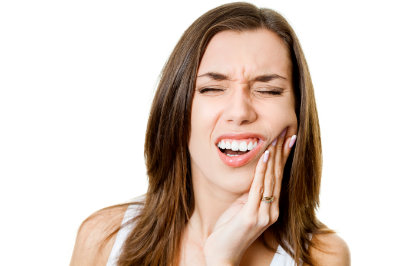Discomfort and Pain in dentistry is very complicated and can usually arise from one or several of the following structures:
- Teeth
- Gums and Soft tissues in the mouth
- Ligaments and Bone Around Teeth
- Jaws
- Temporo-Mandibular Joints (TMJ)
- Muscles associated with chewing and TMJ
- Muscles of the face
- Nerves in the head and neck
- Sinuses
- Other organs of the body that cause referred pain in the head and neck

Teeth
As you may know, teeth are complex structures and are made up of 3 layers – the enamel (an outer protective shell), the dentin (an inner nurturing shell) and the pulp (blood vessels and nerve endings). A healthy pulp allows you to “feel” your teeth, and they are the reasons why your teeth get sensitive when you drink or eat something very cold.
Teeth are made up of three structures: Enamel which is the outer most covering of all of our teeth – a dead structure just like our hair but is the hardest structure in our body. Dentin is the inner layer which is yellow in color and has tiny tubes filled with fluids allowing stimuli and bacteria to be transmitted to the ‘nerve’ of the tooth. The pulp which is the inner core of the tooth, containing blood vessels, lymphs and nerves – this is what keeps the tooth alive and gives the tooth itself sensation to various stimuli such as cold and hot.
The tooth is attached to the bone and to the gums with specialized ligaments called periodontal and gingival fibers.
Some teeth have a single root but most have multiple roots giving them strength and stability.

Cavities, Caries or Decay
Cavities, Caries or Decay is a term used to describe a rampant uncontrollable disease of the teeth. It is the most commonly found disease (yes even more than flu) affecting human beings. It is caused mainly by bacteria feeding on sugars and carbohydrates, creating acids, which eventually lead to the demineralization (removal of the hard minerals) of the enamel and eventual breakdown of the enamel. Bacterial then infiltrate and infect this new “cavity” and reach the dentin. Through the tiny tubes of dentin, bacteria eventually find their way to the pulp (nerve) of the tooth and infect it. This infection eventually gets to the ligaments around the tooth and the jaw bone which can causes abscesses and bodily infections and sicknesses.
Cavities can be treated with fluoride therapy, silver diamine fluoride, resin infiltration, restorations, root canal treatment or extractions.

Chips, Fractures and Cracks
Chips, Cracks and fractures of the teeth happen due to various mechanical and physical blows to teeth. The enamel of the tooth is a brittle material like ceramics (more brittle than bone) and it can develop cracks, chips and fractures which can propagate into the dentin – causing sensitivity to hot and cold and eventually into the pulp – causing severe pain to biting and throbbing pain or reach the bone – causing severe pain to biting and touching the tooth. This allows bacteria to get into the pulp (nerve) of the tooth causing infections and abscesses just like cavities can.
Depending on the extent of the chip, crack of fracture, restorations, root canal therapy or extractions may be recommended.

Gums and Soft Tissues in the Mouth
The gums or the gingiva is a specialized skin in the mouth that protects the teeth and its surrounding structures from microorganisms, bacteria and other foreign objects. It forms a protective barrier just like our skin but it is slightly more complex due to the presence of teeth and many vital structures it protects. The rest of the mouth where there are no teeth is covered by mucosa. The gums or the mucosa of the mouth can be affected by various diseases that can cause discomfort and pain including periodontal and gingival disease, viral and fungal infections, cysts and tumours, mucosal pathologies, etc.
Periodontal and Gingival Disease
The area where the gums and the teeth meet contains a small pocket that can be filled with bacteria and other micro-ogranisms – we call this a periodontal pocket. If the pocket is not cleaned regularly, the micro-organisms that accumulate in it, may start to break down the gingival and periodontal fibers, cause the gums or the gingiva around teeth to swell up and start bleeding and eventually cause loss of bone and the supporting structures of the teeth. This is called periodontitis.
Gingivitis is a reversible disease of the gums when they are inflammed but there has been no irreversible damage to the bone surrounding teeth and Periodontitis, although reversible, is a disease where damage is already done to the bone and tissues surrounding teeth.
Periodontitis can be treated by Scaling and Root Planing (Cleaning), Periodontal Surgeries, Gingival Grafting and Regeneration, Bone Grafting and Regeneration or Extractions.
Ligaments and Bone Around Teeth
The ligaments and the bone (alveolus) around teeth is specially designed to suspend the tooth and distribute the forces put on teeth. They also have specialized nerve endings that allow it to sense pressure. The ligaments are called periodontal fibers. Periodontitis (gum disease) and Caries (cavities/decay) can eventually allow bacteria and other micro-organisms to reach these areas and cause inflammation or swelling of the ligaments and the eventual breakdown of the bone around teeth. This typically results in pain to biting on the affected tooth or teeth.
As always the source of the infection or inflammation has to be determined and removed for the eventual resolution of this condition. The ligaments and the bone can also sometimes be inflammed due to severe bruxism and grinding of teeth or obviously traumatic incidents.

